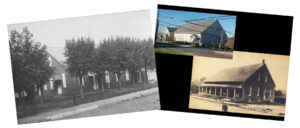
Churches and religion have long played a pivotal role in the development of this community and many buildings and traditions are still valued by Souderton residents today. The longest standing church in Souderton is the Souderton Mennonite Church, the first Meetinghouse dedicated on Christmas Day, 1879.
Prior to construction of Souderton Mennonite Church, religion was largely practiced inside the home. The few hundred residents of this area (before incorporation as Souderton Borough) would travel to nearby churches in Franconia for special occasions, but would either need to walk or catch a ride on a horse & buggy to get there. While faith was incredibly important to many early residents, church-going was certainly not a weekly occurrence.
The first Mennonite Meetinghouse was built on the corner of Chestnut Street and Wile Avenue, in the same place that the church stands today. This building was constructed for a total cost of $2,503 under the guidance of Building Committee members Henry O. Souder, Jacob Detweiler, Joseph Bergey, and Enos Moyer. These gentlemen have last names that may be very familiar to Souderton residents today, and many of their decedents remain in the area. It’s likely some even still attend Souderton Mennonite Church!
Even with the construction of this new church building, services were not held weekly as they are today. Church services were held only once a month until 1888, when congregants began to meet every other week. There was no minister during this time. Ministers were provided by surrounding churches or services were conducted by laypeople until 1914 when Jacob M. Moyer was chosen as the first minister of Souderton Mennonite Church.
The original Meetinghouse building was torn down in 1915 to make way for a larger building on the same lot. This new building had a seating capacity of about 1,000 people. In the photo above at right, you can see that the current façade of the building facing Wile Avenue is this same 1915 design. The placement of doors, windows, and chimney are all original to the building.
The cemetery located at Souderton Mennonite Church also dates back to the original Meetinghouse. Many notable locals are buried there, including Henry O. and Hannah Souder and several of their children. In the above left photo, you can see the faint image of a fence around the property. During this time, there were no motorized lawnmowers or weed trimmers to keep the grass and weeds controlled around gravestones. Instead, the church would use sheep to control vegetation in the cemetery! The fence was in place to keep the sheep safely inside the cemetery grounds.
